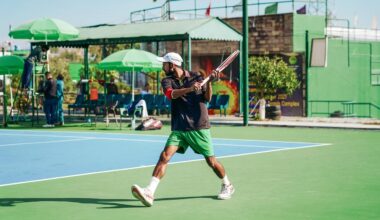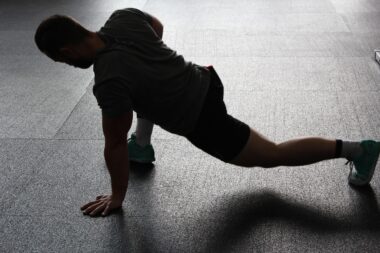Improving Balance and Coordination for Basketball Athletes
Balance and coordination are essential skills for basketball athletes who need to perform at high levels. These qualities enable players to maintain their footing while executing quick movements, whether they’re dribbling, shooting, or passing. Developing these skills helps athletes improve their overall performance, reducing the risk of injury. To achieve better balance, athletes should engage in specific training drills that challenge their stability on various surfaces. Working on coordination enhances hand-eye coordination, making it easier to execute plays efficiently. Strength-based exercises combined with agility drills are advantageous in developing these abilities. Incorporating flexibility training also contributes to balance improvements. It is crucial to maintain a well-rounded regimen focusing on multiple components. Incorporating fitness elements dedicated to agility and explosive movements can help athletes react better during gameplay. A systematic approach to mastering coordination will significantly enhance a player’s ability to predict movements, allowing for quicker adjustments. Additionally, consistent practice fosters muscle memory, further sharpening both balance and coordination skills in competitive settings. Athletes should remember that sustained training is vital in yielding visible results over time, so patience and persistence must accompany their practice efforts.
One effective method for improving balance involves various core strengthening exercises. The core is essential for maintaining stability, as it connects the upper and lower body. By enhancing core strength, players can better manage their body weight during dynamic movements such as twisting, jumping, or landing. A strong, flexible core provides a solid foundation, optimizing movement efficiency. Some beneficial exercises include planks, bridges, and rotational movements. These exercises improve core strength and engage the muscles necessary for maintaining balance on and off the court. Additionally, incorporating stability balls or balance boards into training routines can challenge athletes to stabilize themselves while performing upper body exercises. Engaging in yoga or pilates can also enhance flexibility and core strength. A regular practice can translate into better balance during games, as athletes learn to control their bodies in more challenging positions. Coaches can introduce balance-focused drills during warm-ups or practice sessions to reinforce these skills consistently. Also, players can practice their footwork on uneven surfaces, integrating change-of-direction movements with balance stabilization. Focused training ultimately aids athletes in achieving superior coordination, positively impacting their performance on the basketball court.
Drills to Enhance Coordination
Several drills can be incorporated into training routines to specifically target coordination improvement. For instance, dribbling drills using different basketball techniques can significantly enhance hand-eye coordination. Athletes can use both hands to dribble as they move in different directions, improving their overall control of the ball. Starting with simple crossovers before advancing to behind-the-back dribbles helps players develop responsiveness. Adding obstacles or defenders increases the challenge, encouraging athletes to make quick decisions while maintaining control. Additionally, cone drills help improve foot coordination and agility. By setting up cones in a zig-zag formation, players can maneuver in various directions, practicing explosiveness and control. Other drills include ladder drills focusing on quick foot movements and coordination. Implementing these drills regularly during practice sessions keeps skills sharp and builds muscle memory over time. Consistency in performing these drills will enhance overall basketball performance. Remember that athletes should always prioritize form and technique to gain maximum benefits from training. Relying on drills targeted explicitly at coordination provides direct feedback, empowering players to identify areas of improvement in real time while fostering competitive spirit during training.
The Importance of Agility in Basketball
Agility is undeniably a critical skill in basketball, allowing players to change direction rapidly and navigate through defensive setups. For athletes to enhance this skill effectively, a structured agility training program should be integrated into their workout regime. The goal of agility training is not just about speed; it’s also about improving reaction time and overall body control. Cone drills, shuttle runs, and ladder drills can provide excellent scaffolding for agility improvement. These exercises require players to accelerate, decelerate, and pivot, mimicking real-life game scenarios. Additionally, agility training can enhance an athlete’s quickness, which is crucial for both offensive and defensive plays. Incorporation of plyometric exercises such as box jumps and lateral hops can further contribute to agility development. Focusing on explosive movements trains the body to respond quickly to on-court actions. Moreover, agility training enhances a player’s ability to maintain balance when shifting directions at high speeds. Proper agility training not only improves performance but reduces the chances of injuries caused by sudden movements. Continuous evaluation during agility drills helps identify areas for improvement.
Incorporating a variety of targeted exercises can significantly boost both balance and coordination. Practice makes permanent, therefore athletes should aim for consistency. Structuring a balanced training routine tailored for different aspects of athletic performance is essential. Regularly engaging in designated agility drills, core exercises, and flexibility training significantly elevates players’ skills over time. Establishing a sustainable routine is key; athletes need to set achievable goals. Progress monitoring encourages continuous improvement in their skill sets, reducing the chance of stagnation. A balanced approach facilitates the enhancement of overall athleticism, ensuring a well-rounded performance. Players should remember to incorporate rest and recovery into their schedules, allowing muscles to recuperate fully. Additionally, maintaining proper nutrition supports muscle recovery and function. Athletes will experience improved concentration and coordination by prioritizing nutrition. Engaging in mindfulness practices can enhance focus, leading to more refined skills. Balancing mental and physical training sessions leads to comprehensive development as an athlete. Players should also maintain an effective feedback loop with trainers, permitting personalized adjustments based on assessments. This creates a feedback-rich environment crucial for faster learning and enhancements in athletic performance.
Utilizing Technology for Improvement
Modern technology provides innovative solutions to aid basketball athletes in enhancing balance and coordination. Wearable devices such as fitness trackers and smart shoes can deliver invaluable data about an athlete’s movements and performance metrics. These insights allow coaches and players to identify specific areas requiring focus. Video analysis technology provides further depth, enabling athletes to analyze their form during training or gameplay actively. Coaches can use video replays to highlight specific movements that require refinement. Furthermore, mobile apps dedicated to basketball training offer challenging drills tailored to individual needs, significantly improving athletes’ skills. Engaging in virtual training environments can foster a new level of skill acquisition. With simulation technology, basketball players can practice game scenarios that require quick decision-making without the presence of an adversary. This emerging technology allows them to refine their techniques, leading to improved coordination and balance. Implementing these technological advancements follows the trends in sports science, allowing athletes to maximize performance. To stay ahead, athletes should embrace these tools and integrate them into their training regimens, ensuring they remain competitive while achieving personal bests.
Ultimately, enhancing balance and coordination is an ongoing journey for basketball athletes seeking to optimize their performance on the court. Regular training blended with proper recovery practices leads to successful skill acquisition. Fostering a mindset of growth will ensure athletes remain dedicated to self-improvement. As they progress, players should reassess their goals periodically to encourage continued development. Cultivating teamwork during practice sessions can also bolster communication, providing mutual benefit in refining coordination. Coaches play a vital role in creating a supportive environment for athletes, promoting teamwork, and enhancing individual skills. By emphasizing a holistic approach, athletes can achieve balance both physically and mentally. It’s essential for players to work collaboratively in pursuit of common objectives, nurturing an environment that fosters a sense of belonging. Moreover, valuable insights can emerge from teammates regarding balance and coordination. Building a support system in this journey ensures sustainability in their training goals. In conclusion, through consistent effort and dedication, basketball players can improve their skills in balance and coordination, enhancing their overall game. With commitment, they can unlock their full potential on the basketball court.






